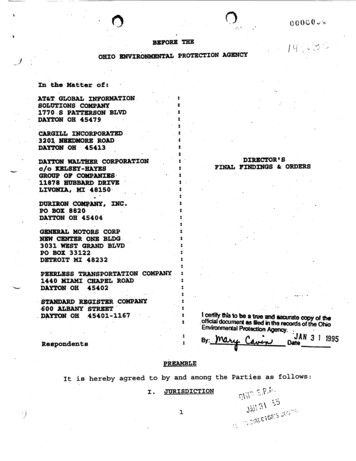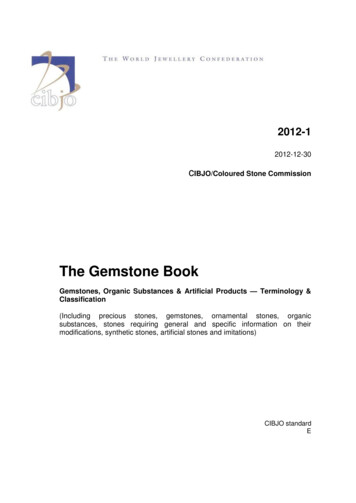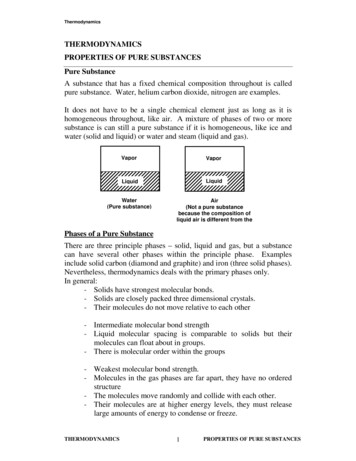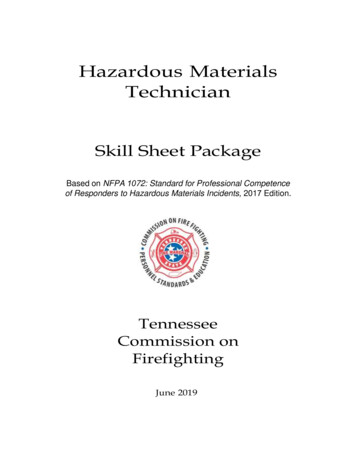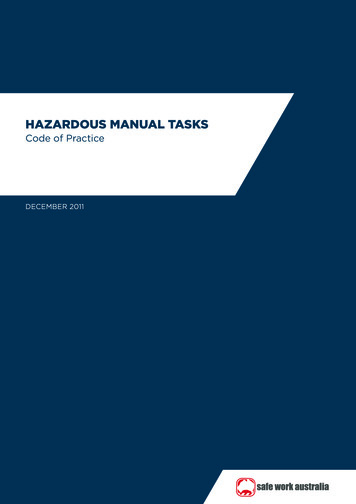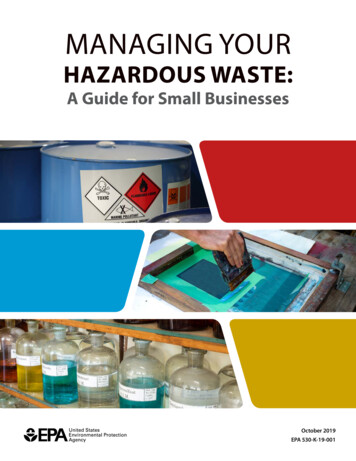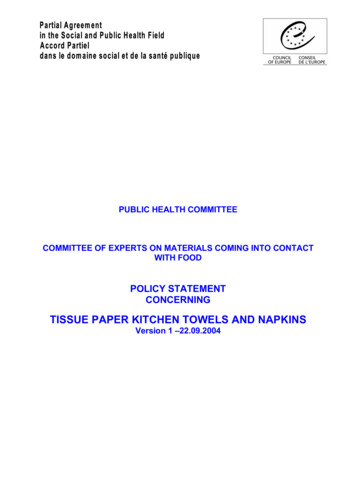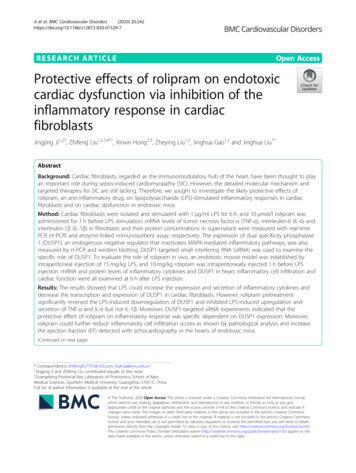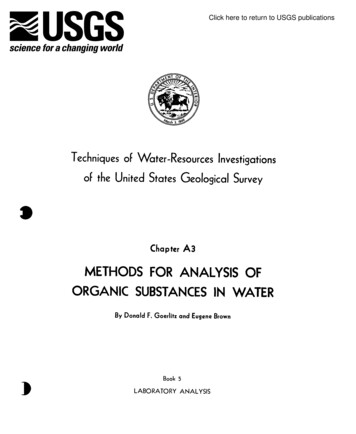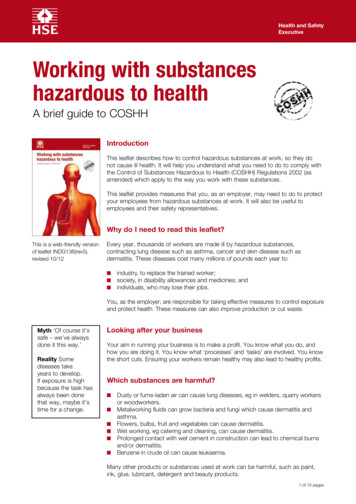
Transcription
Health and SafetyExecutiveWorking with substanceshazardous to healthA brief guide to COSHHIntroductionThis leaflet describes how to control hazardous substances at work, so they donot cause ill health. It will help you understand what you need to do to comply withthe Control of Substances Hazardous to Health (COSHH) Regulations 2002 (asamended) which apply to the way you work with these substances.This leaflet provides measures that you, as an employer, may need to do to protectyour employees from hazardous substances at work. It will also be useful toemployees and their safety representatives.Why do I need to read this leaflet?This is a web-friendly versionof leaflet INDG136(rev5),revised 10/12Every year, thousands of workers are made ill by hazardous substances,contracting lung disease such as asthma, cancer and skin disease such asdermatitis. These diseases cost many millions of pounds each year to: industry, to replace the trained worker; society, in disability allowances and medicines; and individuals, who may lose their jobs.You, as the employer, are responsible for taking effective measures to control exposureand protect health. These measures can also improve production or cut waste.Myth ‘Of course it’ssafe – we’ve alwaysdone it this way.’Reality Somediseases takeyears to develop.If exposure is highbecause the task hasalways been donethat way, maybe it’stime for a change.Looking after your businessYour aim in running your business is to make a profit. You know what you do, andhow you are doing it. You know what ‘processes’ and ‘tasks’ are involved. You knowthe short cuts. Ensuring your workers remain healthy may also lead to healthy profits.Which substances are harmful? Dusty or fume-laden air can cause lung diseases, eg in welders, quarry workersor woodworkers. Metalworking fluids can grow bacteria and fungi which cause dermatitis andasthma. Flowers, bulbs, fruit and vegetables can cause dermatitis. Wet working, eg catering and cleaning, can cause dermatitis. Prolonged contact with wet cement in construction can lead to chemical burnsand/or dermatitis. Benzene in crude oil can cause leukaemia.Many other products or substances used at work can be harmful, such as paint,ink, glue, lubricant, detergent and beauty products.1 of 10 pages
Health and SafetyExecutiveMyth ‘It’s natural soit can’t be harmful.’III health caused by these substances used at work is preventable. Manysubstances can harm health but, used properly, they almost never do.Reality Naturalmaterials can beharmful. For example,henna can causedermatitis andasthma, wood dustcan cause asthma,stone or concretedust can cause lungdisease such assilicosis, and citrusoils can cause skinproblems.Find out the dangers in your business – ask your supplier, your trade association,and check for your industry on HSE’s website: www.hse.gov.uk.Substances can also have other dangerous properties. They may be flammable, forexample solvent-based products may give off flammable vapour. Clouds of dustfrom everyday materials, such as wood dust or flour, can explode if ignited. Thisleaflet does not deal with flammability or explosion hazards (see ‘Find out more’).Look at each substanceWhich substances are involved? In what way are they harmful? You can find out by: checking information that came with the product, eg a safety data sheet;asking the supplier, sales representative and your trade association;looking in the trade press for health and safety information;checking on the Internet, eg HSE’s website pages for your trade.Think about the taskIf the substance is harmful, how might workers be exposed? By:Myth ‘I don’twork with harmfulsubstances.‘Reality Mostbusinesses usesubstances thatcan be hazardousto health – evensomething as simpleas flour can act as asubstance hazardousto health. breathing in gases, fumes, mist or dust?contact with the skin?swallowing?contact with the eyes?skin puncture?Bear these in mind when you look at the tasks.Exposure by breathing inOnce breathed in, some substances can attack the nose, throat or lungs whileothers get into the body through the lungs and harm other parts of the body, egthe liver.Exposure by skin contactSome substances damage skin, while others pass through it and damage otherparts of the body. Skin gets contaminated: by direct contact with the substance, eg if you touch it or dip your hands in it;by splashing;by substances landing on the skin, eg airborne dust;by contact with contaminated surfaces – this includes contact withcontamination inside protective gloves.Exposure by swallowingPeople transfer chemicals from their hands to their mouths by eating, smoking etcwithout washing first.Exposure to the eyesSome vapours, gases and dusts are irritating to eyes. Caustic fluid splashes candamage eyesight permanently.Working with substances hazardous to health2 of 10 pages
Health and SafetyExecutiveExposure by skin punctureRisks from skin puncture such as butchery or needlestick injuries are rare, but caninvolve infections or very harmful substances, eg drugs.Safety data sheetsEuropean symbolsT Products you use may be ‘dangerous for supply’. Ifso, they will have a label that has one or more hazardsymbols. Some examples are given here.iToxicThese products include common substances ineveryday use such as paint, bleach, solvent or fillers.When a product is ‘dangerous for supply’, by law, thesupplier must provide you with a safety data sheet.Note: medicines, pesticides and cosmetic productshave different legislation and don’t have asafety data sheet. Ask the supplier how the productcan be used safely.Safety data sheets can be hard to understand, withlittle information on measures for control. However, tofind out about health risks and emergency situations,concentrate on:Very gerousto theenvironmentOxidisingCorrosiveF HighlyflammableNew International symbols Sections 2 and 16 of the sheet, which tell you whatthe dangers are; Sections 4-8, which tell you about emergencies,storage and handling.Since 2009, new international symbols have beengradually replacing the European symbols. Some ofthem are similar to the European symbols, but there isno single word describing the hazard. Read the hazardstatement on the packaging and the safety data sheetfrom the supplier.Hazard checklistDoes any product you use have a danger label?Does your process produce gas, fume, dust, mist or vapour?Is the substance harmful to breathe in?Can the substance harm your skin?Is it likely that harm could arise because of the way you use or produce it?What are you going to do about it?- Use something else?- Use it in another, safer way?- Control it to stop harm being caused?Working with substances hazardous to health3 of 10 pages
Health and SafetyExecutiveMyth ‘What do youexpect – it’s a dirtyjob!’Reality Why doesyour job need to bedirty? Think aboutchanging the wayyou work to producecleaner processes.Assessing riskRisk assessment is not just a paper exercise. It’s about taking sensible steps toprevent ill health. You need to know how workers are exposed, and to how much,before you can decide if you need to do anything to reduce their exposure. TheCOSHH Regulations require employers to assess the risk to their employees, and toprevent or adequately control those risks. Sometimes, it’s easy to judge the amountof exposure to substances and decide what you can do about it.When the task involves very small amounts of material, even if these are harmful,when there is little chance of it escaping, the risk is low. But the risk in a differenttask – such as cleaning up and disposal – will be higher because the harmfulsubstance may be breathed in or get onto the skin.When the task involves larger amounts of material, with obvious leaks, exposureis higher and so is the risk. Whether the substance is harmful or not, your need tocontrol it is obvious. Decide what measures you need to take, and when.If you have five or more employees, you must record your assessment but, even ifyou have fewer than five, it makes sense to write down what steps you have takento identify the risks. And the really important part is making a list of the actionsyou are taking to control the risks to health. You can look at examples of riskassessments for different industries on www.hse.gov.uk/risk/casestudies.HSE has developed a free internet tool for identifying good control practice:www.coshh-essentials.org.uk. It covers a wide range of processes and activitiesand also produces advice for products that have safety data sheets.However, there may be no ‘good practice’ advice available for your process. Wherethis is small-scale with obvious control measures, you can do the assessmentyourself. In other cases, or where you are not sure, ask your supplier, tradeassociation or other reliable information sources. You may need professional advicesuch as from an occupational hygienist – see ‘Getting help’.What are exposure control measures?Control measures are always a mixture of equipment and ways of working toreduce exposure. The right combination is crucial. No measures, however practical,can work unless they are used properly.So any ‘standard operating procedure’ should combine the right equipment withthe right way of working. This means instructing, training and supervising theworkers doing the tasks.You need control measures that work and continue to work – all day, every day.Working with substances hazardous to health4 of 10 pages
Health and SafetyExecutiveExamples of control measuresSubstance, processControl equipmentWay of workingManaging Cleaning with solvent onrag. Use a rag holder.Provide a small bin with a lid forused rags. Avoid skin contact.Reduce solvent vapour from usedrags. Check controls are used.Safe disposal. Dust and sparks fromabrasive wheel. Put an enclosure around thewheel and extract the air to asafe place. Check the airflow indicator.Make sure the extraction works. Maintain controls.Test controls as requiredby law. Fume from cuttingdemolition scrap. Ventilated welding helmet,gloves.Washing facilities. Work outdoors upwind of thefume wherever possible.Allow the fume to clear beforeremoving helmet. Check if there is any leadpaint on the scrap beingcut.Carry out health checks.Use skin-care products.Make sure the extraction works.Allow time for the mist to clearfrom the enclosure beforeopening it. Cutting-fluid mist from alathe.Swarf. Dust from disc cutter onstone worktop. Myth ‘They wouldn’tsell it to us if it wasn’tsafe.’Reality Just becausesomething is availableto buy, does notmean it is safe – youcan buy cyanide forindustrial use.Put an enclosure around thelathe and extract the air to asafe place.Protective gloves.Use an enclosure to extract airto a safe place.High-efficiency vacuum cleaner. Cut and polish worktops insidean enclosure.Vacuum up dust. Train workers.Check and maintain fluidquality.Test controls as requiredby law.Carry out health checks. Test and maintain controls.Carry out health checks. Choosing control measuresIn order of priority:1234567Eliminate the use of a harmful product or substance and use a safer one.Use a safer form of the product, eg paste rather than powder.Change the process to emit less of the substance.Enclose the process so that the product does not escape.Extract emissions of the substance near the source.Have as few workers in harm’s way as possible.Provide personal protective equipment (PPE) such as gloves, coveralls and arespirator. PPE must fit the wearer.If your control measures include 5, 6 and 7, make sure they all work together.Control equipmentControl equipment comes in many forms. It includes ventilation to extract dust,mist and fume; glove boxes and fume cupboards; spray booths and refuges (cleanrooms in dirty work areas). It also includes using water to reduce dust, and systemsfor disinfecting cooling water.For control equipment, your supplier should provide a ‘user manual’. If you don’thave one, ask for it. And if this is impossible, you may need professional help towrite one. The user manual should set out schedules for checks, maintenance andparts replacement. For example it should include:Working with substances hazardous to health5 of 10 pages
Health and SafetyExecutiveMyth ‘I’ve given themall masks – problemsolved!’ a description of the system; the daily checks the worker or supervisor needs to carry out, eg the ventilation isturned on, the airflow indicator gives the right reading; the weekly or monthly checks the supervisor or owner needs to carry out, eg ofReality This won’tsolve it. Control thesource of exposureand then they mightnot need masks. equipment wear and tear, and that short cuts are not creating dangers;details of any thorough examination and test;signs of wear and control failure;a list of replaceable parts;a description of how operators should use the system so it works effectively.Remedy defects in good time. It is pointless making checks if you take no actionwhen something is wrong. And you are not managing health and safety properly ifthe ‘thorough examination and test’ produces a long list of ‘actions needed’.Keep simple records of your checks and actions, eg in a logbook, and keep theserecords for at least five years.Staying in control: Checking and maintainingOnce you’ve got control, you need to keep it. As the employer, you must makesure that the control measures (equipment and the way of working) keep workingproperly.You should name someone to be in charge of checking and maintaining controlmeasures. It could be you, or someone you appoint, as long as they know whatthey need to do, and are able to do it. That is, they are ‘competent’ to: check that the process isn’t emitting uncontrolled contaminants; check that the control equipment continues to work as it was designed; check that workers follow the right way of working.Two of the most common control measures where maintenance is critical are localexhaust ventilation (LEV) and personal protective equipment (PPE).Local exhaust ventilation (LEV)If you use local exhaust ventilation to control exposure, it needs regular checkingand thorough examination and testing at least once every 14 months or at morefrequent intervals if you are using it with one of the processes listed in Schedule 4of COSHH.Many people, eg engineers or insurance companies can carry out thoroughexamination and testing of LEV. Whoever does the work must be competent – see‘Getting help’.Personal protective equipment (PPE)Personal protective equipment is often used as part of control measures. Thisalso needs checking and maintenance because, if it fails, it no longer providesprotection and exposes the wearer to danger. The users need to know exactlywhat they are doing, and so do the supervisors.PPE suppliers and trade associations can tell you about training in how to use itproperly. See ‘Getting help’ and ‘Further information’.Working with substances hazardous to health6 of 10 pages
Health and SafetyExecutiveChecklist for good control practiceDo you design and run your processes to keep the spread of contaminantsas low as possible?Do you think about all routes of exposure – breathing in, on skin orswallowing?Do you choose control measures according to the amount of substance, howit gets into the body and how much harm it will cause?Do you make sure that measures are effective, easy to use, and workproperly?Do you also need to issue personal protective equipment (PPE)?Do you check regularly that measures continue to work, and keep simplerecords?Do you tell workers about the dangers and how to use control measuresproperly?Do you avoid increasing the overall health and safety risks when makingchanges?Skills and experienceCompetenceEnsure that whoever designs, installs, maintains and tests your control measuresis competent – they have the necessary skills, knowledge and experience. You canassess the competence of equipment and service providers with questions suchas: Have you done this sort of work before?What are your qualifications?Do you belong to a professional organisation?Can I speak to previous clients?Ideally, you want someone who knows your industry, has a successful track record,and gives good value for money.Worker involvementInvolve your workers in developing control measures to make sure they are suitablefor the way they carry out the work. Encourage them to suggest improvements,and to report anything they think might be going wrong.Training, instruction and informationExplain to your workers, and anyone else who needs to know, what the dangersare. It is poor practice just to hand them a page of written information. Show workers how to use control measures properly, and how to check thatthey are working. Carry out practice drills for cleaning up spills safely – do this before any spillageshappen. If workers need to use respirators, they also need face fitting and training. If they need to use protective gloves, they need to know how to put them onand take them off without contaminating their skin. See ‘Find out more’.Working with substances hazardous to health7 of 10 pages
Health and SafetyExecutiveKeeping workers healthyMonitoring exposureMonitoring normally means air sampling but it may also involve taking biologicalsamples, eg breath or urine. Monitoring normally makes reference to ‘WorkplaceExposure Limits’ (WELs) published by HSE. These limits should not be exceeded(see EH40 in ‘Find out more’).It is wasteful to try monitoring before you have put any control measures in place(see COSHH essentials sheet G409 www.hse.gov.uk/pubns/guidance/g409.pdf onair monitoring).Health checksIf your trade press, HSE, or other information, shows there is a problem with healthin your trade, such as asthma or dermatitis, your employees may need specialhealth checks. The most common checks are for respiratory disease such asasthma and skin disease. See ‘Find out more’.REACHREACH is a European Union regulation concerning the Registration, Evaluation,Authorisation and restriction of CHemicals. It came into force on 1 June 2007and replaces a number of European Directives and Regulations with a singlesystem.REACH will operate alongside COSHH and is designed so that better informationon the hazards of chemicals and how to use them safely will be passed down thesupply chain by chemical manufacturers and importers through improved safetydata sheets.Further information can be found on HSE’s website: www.hse.gov.uk/reach/ andon the European Chemical Agency’s website:www.echa.europa.eu/home en.asp.Working with substances hazardous to health8 of 10 pages
Health and SafetyExecutiveGetting helpWhat andwho?TradeHSEassociationConsultants/service suppliersLocal health andsafety groups3Good control333Testing LEV333Training333Monitoring33Health checks333This is not an inclusive list, but some useful sources of information and help are: The Occupational Safety and Health Consultants Register (OSHCR)www.hse.gov.uk/oshcr/index.htmOSHCR is a register of consultants who can offer general advice to UK businessesto help them manage health and safety risks. British Occupational Hygiene Society (BOHS) 5/6 Melbourne Business Court,Millennium Way, Pride Park, Derby, DE24 8LZ. Tel: 01332 298101 www.bohs.org.BOHS is the professional body for occupational hygienists, who understand howworkplace hazards affect worker health and systems to control risks to health fromwork. The website has a list of consultants. Health & Safety Laboratory (HSL) Business Development Group, Health &Safety Laboratory, Harpur Hill, Buxton, Derbyshire SK17 9JN. Tel: 01298 218000www.hsl.gov.uk.HSL’s services include specialist advice and consultancy, risk assessment, andworkplace monitoring (including biological monitoring). Institution of Occupational Safety and Health (IOSH) The Grange, HighfieldDrive, Wigston, Leicestershire LE18 1NN. Tel: 0116 2573100 www.iosh.co.uk.IOSH is the association for health and safety professionals. The website allows youto search for consultants. United Kingdom Accreditation Service (UKAS) 21-47 High Street, Feltham,Middlesex TW13 4UN. Tel: 02089 178400 www.ukas.com.The UKAS website has a search function to find accredited testing and inspectionservice providers. Trade associations Health and safety information is often produced by tradeassociations and published in the trade press. Occupational health professionals (doctors or nurses) Look in YellowPages or other trade indexes for occupational health under ‘Health and SafetyConsultants’ or ‘Health Authorities and Services’, or visit www.nhsplus.nhs.uk. Safety Groups UK (SGUK) Edgbaston Park, 353 Bristol Road, Edgbaston,Birmingham B5 7ST Tel: 0121 248 2011 www.safetygroupsuk.org.ukWorking with substances hazardous to health9 of 10 pages
Health and SafetyExecutiveFind out moreHSE COSHH website: www.hse.gov.uk/coshh/index.htmA short guide to the Personal Protective Equipment at Work Regulations 1992Leaflet INDG174(rev1) HSE Books 2005 www.hse.gov.uk/pubns/indg174.pdfClearing the air: A simple guide to buying and using local exhaust ventilation (LEV)Leaflet INDG408 HSE Books 2008 www.hse.gov.uk/pubns/indg408.pdfEH40/2005 Workplace exposure limits: Containing the list of workplace exposurelimits for use with the Control of Substances Hazardous to Health Regulations 2002(as amended) Environmental Hygiene Guidance Note EH40 (Second edition)HSE Books 2011 ISBN 978 0 7176 6446 7www.hse.gov.uk/pubns/books/eh40.htmFire and explosion: A brief guide to DSEAR in the workplace Leaflet INDG370(rev1)HSE Books 2012 www.hse.gov.uk/pubns/indg370.pdfPreventing contact dermatitis at work Leaflet INDG233(rev1) HSE Books 2007www.hse.gov.uk/pubns/indg233.pdfRead the label: How to find out if chemicals are dangerous Leaflet INDG352(rev1)HSE Books 2010 www.hse.gov.uk/pubns/indg352.pdfRespiratory sensitisers and COSHH: Breathe freely – An employers’ leaflet onpreventing occupational asthma Leaflet INDG95(rev2) HSE Books 1995www.hse.gov.uk/pubns/indg95.pdfFurther informationFor information about health and safety, or to report inconsistencies or inaccuraciesin this guidance, visit www.hse.gov.uk/. You can view HSE guidance online andorder priced publications from the website. HSE priced publications are alsoavailable from bookshops.This guidance is issued by the Health and Safety Executive. Following the guidanceis not compulsory, unless specifically stated, and you are free to take other action.But if you do follow the guidance you will normally be doing enough to comply withthe law. Health and safety inspectors seek to secure compliance with the law andmay refer to this guidance.This leaflet can be found at www.hse.gov.uk/pubns/indg136.htm Crown copyright If you wish to reuse this information visit www.hse.gov.uk/copyright.htm for details. First published 10/12.Published by the Health and Safety ExecutiveINDG136(rev5)10/1210 of 10 pages
Examples of control measures Substance, process Control equipment Way of working Managing Cleaning with solvent on rag. Use a rag holder. Provide a small bin with a lid for used rags. Avoid skin contact. Reduce solvent vapour from used rags. Check controls are used. Safe disposal. Dust and sparks from abrasive wheel.
